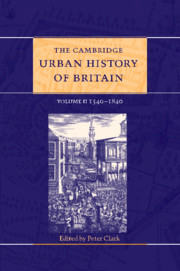Book contents
- Frontmatter
- 1 Introduction
- Part I Area surveys 1540–1840
- Part II Urban themes and types 1540–1700
- Part III Urban themes and types 1700–1840
- 14 Urban growth and economic change: from the late seventeenth century to 1841
- 15 Population and society 1700–1840
- 16 Politics and government 1700–1840
- 17 Culture and leisure 1700–1840
- 18 The transformation of urban space 1700–1840
- 19 London 1700–1840
- 20 Regional and county centres 1700–1840
- 21 Ports 1700–1840
- 22 Small towns 1700–1840
- 23 Health and leisure resorts 1700–1840
- 24 Industrialising towns 1700–1840
- 25 Conclusion
- Select Bibliography
- Index
- References
14 - Urban growth and economic change: from the late seventeenth century to 1841
from Part III - Urban themes and types 1700–1840
Published online by Cambridge University Press: 28 March 2008
- Frontmatter
- 1 Introduction
- Part I Area surveys 1540–1840
- Part II Urban themes and types 1540–1700
- Part III Urban themes and types 1700–1840
- 14 Urban growth and economic change: from the late seventeenth century to 1841
- 15 Population and society 1700–1840
- 16 Politics and government 1700–1840
- 17 Culture and leisure 1700–1840
- 18 The transformation of urban space 1700–1840
- 19 London 1700–1840
- 20 Regional and county centres 1700–1840
- 21 Ports 1700–1840
- 22 Small towns 1700–1840
- 23 Health and leisure resorts 1700–1840
- 24 Industrialising towns 1700–1840
- 25 Conclusion
- Select Bibliography
- Index
- References
Summary
every schoolchild knows that an Industrial Revolution in late eighteenth-century Britain was followed by massive, rapid, urbanisation; that technological change created a world in which people interacted with nature and each other through work in new ways, and therefore lived different kinds of lives in places of a sort previously unknown; that the innovation of powered machinery sucked the British population into factory towns at hitherto remote locations. These novitiate certainties are a stark contrast to the disagreements of expert historians about the nature of economic development and urban growth, and the ways in which they were related, in Britain during the eighteenth and nineteenth centuries.
There has been vigorous argument about what, exactly, the Industrial Revolution was ever since the term was first used. Recently, econometric analysis has even brought its very existence into question: whether the structure or growth trend of the British economy changed significantly before the 1840s is now hotly disputed. The high rates of urbanisation standing proudly in the statistical rubble created by this demolition job are not as incongruous as they might once have seemed. Complementary attacks on the idea that there was an Industrial Revolution in late eighteenth-century Britain, based on hypotheses about the processes of change rather than on trends in economic series, stress the continuing overweening significance of London through the eighteenth century, and are replacing Thomas Gradgrind’s Coketown with Samuel Pickwick’s Eatanswill as the fictional exemplar of provincial urban life.
- Type
- Chapter
- Information
- The Cambridge Urban History of Britain , pp. 451 - 490Publisher: Cambridge University PressPrint publication year: 2000
References
- 10
- Cited by

